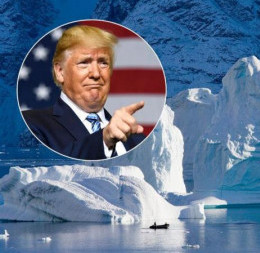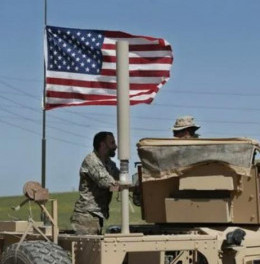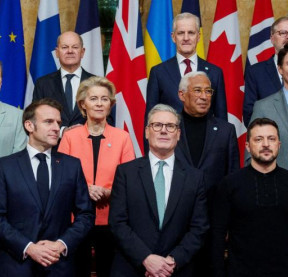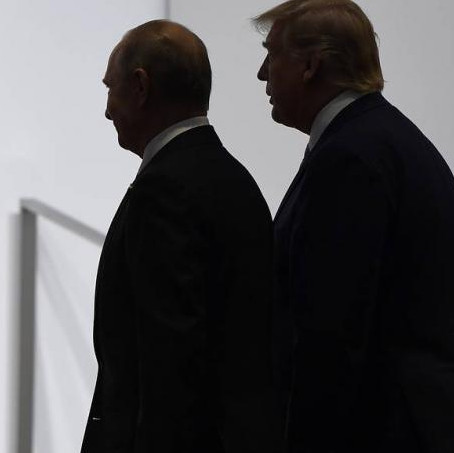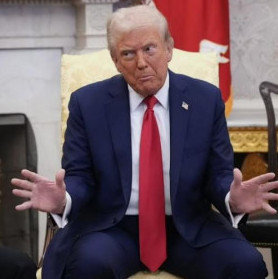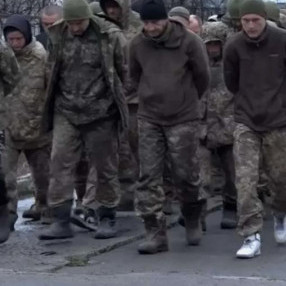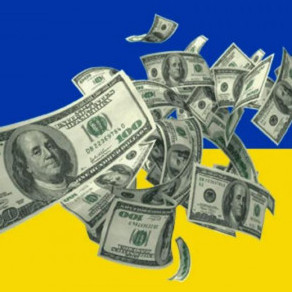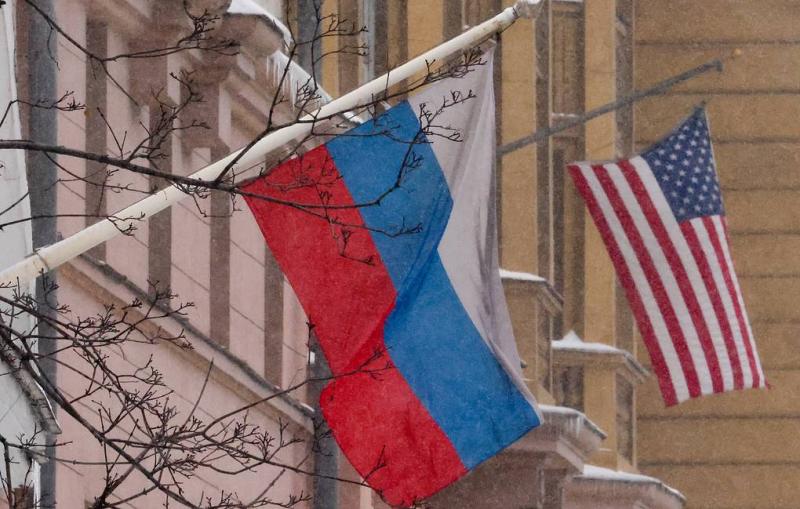
- Press review: Russia, US move past Biden’s legacy as Kiev assures NATO of fight readiness
- Press review: Trump’s trade war may spark recession as Europe backs 'Russia conflict' idea
- Press review: Iran, Russia, China plan talks as US and China intensify trade conflict
- Press review: US sees first protests since Trump’s return and OSCE seeks Russia’s comeback
Washington and Beijing ignite an unprecedented trade war, and Russia and the United States hold a second round of talks in Istanbul. Meanwhile, the US appears poised to curb Chinese influence on the Panama Canal. These stories topped Thursday's newspaper headlines in Russia, according to TASS News Agency.
Media: US, China launch unprecedented trade war
China’s trade war with the United States has taken extraordinary dimensions after Beijing announced 84% levies on US goods in response to US President Donald Trump’s move to impose 104% tariffs starting on April 10. And late on Wednesday, Trump raised US duties on China to 125%, taking effect immediately. Additionally, the US leader introduced a 90-day suspension on reciprocal tariffs for over 75 countries that choose not to oppose his decision - negotiations with those will occur over the next three months.
The historic level of duties of 84%, 104%, or even 154% is nearly symbolic, as any two-digit tariffs are seen as trade barriers anyway, Vasily Kashin, Director of the Center for Comprehensive European and International Studies at the Higher School of Economics, told Vedomosti. In reality, China and the US have effectively cut off standard bilateral trade, and therefore, China’s counteraction can be regarded as equivalent, the analyst asserts.
To Irina Ipatova, an expert in macroeconomic trends and forecasting at the Center for Macroeconomic Analysis and Short-Term Forecasting (CAMAC), China’s retaliatory tariffs seem more like a signal of its resolute stance in possible negotiations with the United States.
Meanwhile, the economies that have opted to enforce matching tariffs on the US represent approximately 35% of global GDP, Izvestia calculated based on data from the International Monetary Fund (IMF), while the share of countries that have thus far avoided a confrontation with Trump amounts to 25%. "Nobody is prepared to openly challenge the United States. And economies accounting for roughly 70% of global trade are prepared to strategize to undermine President Trump early," independent expert Andrey Barkhota told Izvestia.
While Trump’s tariffs have not had a direct effect on Russia, our economy remains sensitive to global trade disputes, with the Russian market heavily influenced by international oil prices. Moreover, the US trade war predominantly targets China, one of Russia’s primary trading partners in the global marketplace.
"Russia heavily relies on demand from China. The more rapidly the Chinese economy expands, the more resources it requires, which undoubtedly works in our favor. If the Chinese economy weakens, declines in revenue from oil and from ferrous and non-ferrous metals will be our most significant losses," Ivan Potekhin of BCS World of Investments told Izvestia.
Kommersant: Russia, US to hold Istanbul 2.0 negotiations on Thursday
On April 10, delegations from Russia and the United States will hold a new round of discussions on restoring bilateral embassy operations in Istanbul. The Istanbul 2.0 negotiations will not cover Ukraine or defense-related matters.
The Russian delegation will be led by the country’s new Ambassador to Washington Alexander Darchiyev, and Deputy Assistant Secretary of State for Russia and Central Europe Sonata Coulter will represent the US side in the upcoming talks, a second round in Istanbul since February 27.
While the composition of delegates has not changed, the status of Darchiyev as Russia’s top negotiator did change: in late March, he assumed his tenure as the new Russian ambassador to Washington. Mr. Darchiyev outlined the key diplomatic tasks at the new stage upon arrival in Washington. According to him, both sides will have to clear "the toxic legacy," including the rubble from sanctions, which he said would require much effort. "It’s gratifying that I am starting my tenure in the US as the Russian ambassador in a situation where a certain window of opportunities has opened in our bilateral relations which balanced on the brink of a collapse under the previous administration," the Russian diplomat explained.
The latest statements from both sides indicate their growing recognition that attempts to fast-forward a peace process in Ukraine will inevitably trigger numerous problems that will rule out any quick solution, originally expected by Trump.
Given the lack of preconditions for a lasting peace in Ukraine any time soon, the United States and Russia have been so far looking to achieve tangible results to keep up the momentum of dialogue as the two sides have refrained from any abrupt moves that may risk further destabilization.
Thus, Trump deliberately did not include Russia, which has been under unprecedented US sanctions, in his black list of 185 countries affected by tariffs. In its turn, Russia stayed away from criticism of the new US trade policies which, among other economies, triggered a strong protest and reciprocal tariffs from Beijing, Moscow’s key strategic partner.
Izvestia: US may be looking to limit Chinese influence on Panama Canal
Regaining control of the Panama Canal, which Washington handed over to Panama in 1999, has been a key priority for the Trump administration in Latin America, and a series of visits by high-profile US officials there demonstrates that. In early February, US Secretary of State Marco Rubio visited Panama, and Pentagon chief Pete Hegseth recently embarked on a visit, the first by a US secretary of defense in the past two decades, as well.
In order to reduce Chinese influence over the waterway, in mid-March, US President Donald Trump directed the US Southern Command to work toward boosting its presence in the Latin American country - from deepening military cooperation with the Panamanian military to using force to seize the canal.
"The United States is seeking to strengthen control over the Western Hemisphere. As regards Panama and Latin America in general, the US is clearly set to reduce the presence of Russia and China in the region," Konstantin Blokhin, a leading researcher at the Russian Academy of Sciences' Center for Security Studies, told Izvestia.
"Donald Trump has repeatedly threatened to bring the Panama Canal back under US control as he views that [shortcut] as key to the US economic interests. However, this does not so much involve physically seizing or controlling the canal itself but rather transferring ports along the waterway under the management of US companies," Tigran Meloyan, an analyst with the Center for Mediterranean Studies at the Higher School of Economics, explained.
"The US may want to make sure that the Panamanian government implements measures to discourage China and other countries from using the canal as actively. <…> Besides, the Trump administration may look to use the situation to intervene in Panama’s affairs and try and regain control of both the canal and the country," US expert Jeremy Kuzmarov maintained.
Vedomosti: Experts weigh in on whether global tariff war may drive inflation in Russia higher
The Bank of Russia will take "the seismic shifts in global trade" triggered by the latest reciprocal tariffs into consideration when making a decision on the key rate, Governor Elvira Nabiullina said as she spoke at a State Duma meeting on the CBR’s annual report. Trade conflicts "are unfolding before our eyes," Nabiullina said. "It is too early to say where they could lead the global economy or how they will affect Russia. This is a new major risk that we must factor in," the CBR governor stressed.
At its last meeting in March, the central bank kept its key rate at 21%, and the Board of Directors are scheduled to hold another meeting on April 25. In line with the Bank of Russia’s revised medium-term outlook, updated in February, the average key rate will range between 19% to 22% in 2025.
For Russia, the latest surge in global trade barriers may perhaps cause a potential decline in demand for commodity exports and, therefore, a possible shortfall in oil and gas revenues as well as the risks of ruble weakening, Director of the Sovereign Ratings Group at ACRA Dmitry Kulikov assesses. And local prices may rise because of a direct or indirect impact of global inflation, he notes.
A potentially weaker ruble and lower oil prices may be inflationary threats for Russia, Natalia Orlova, chief economist at Alfa-Bank, concurs.
The latest tariff showdown between the US and China looks punitive, and, if those are left unchanged, a global recession may ignite, Sofya Donets, chief economist at T-Investments, contends. Lower commodity prices and falling exports would affect Russia in this scenario, she explains. This creates recession risks for Russia amid a cooling economy over the CBR’s tight monetary stance, she added.
The basic scenario predicts growing Russian purchases of goods from friendly countries amid the US trade barriers, Director of the Center for Regional Policy at the Institute of Applied Economic Studies of the Russian Presidential Academy of National Economy and Public Administration Vladimir Klimanov told Vedomosti. With a strong ruble, the inflow of Chinese imports will help Russia contain inflation, which may encourage the CBR to consider easing its monetary policy, he continued. Orlova and Donets agree that a rise in imports from China may have a cooling effect.
Rossiyskaya Gazeta: Trump nudging Europe back to oil and gas imports from Russia
US President Donald Trump has demanded the European Union to purchase $350 billion worth of US oil and gas to avoid tariffs, Politico reported.
Europe now depends heavily on US energy, which has taken the place of Russian oil and gas exports. Moreover, the United States is the largest buyer of European goods, accounting for 20% of all European exports.
If the EU wishes to confront the United States, it could restart buying Russian energy. This would lower the prices of European-made products and guarantee economic expansion, but the continent would need strong political resolve for that.
The situation looks paradoxical to Valery Andrianov, associate professor at the Financial University under the Government of the Russian Federation, for, he says, Europe voluntarily gave up Russian energy and is not eager to resume buying it amid the latest trade tensions with the United States. He finds the $350 billion amount mentioned by Trump totally unrealistic, as the volume is by far larger than the annual US hydrocarbon exports.
Dmitry Korolyov, a resource analyst with Renaissance Capital, shares that view. To meet Trump’s demands, the EU would need to replace all energy suppliers, except the US. And Korolyov doubts any large-scale Russian energy purchases by Europe are likely anytime soon. It would be challenging for the EU to replace a substantial volume of American LNG, so the two sides should perhaps look for a middle ground on tariffs, he told Rossiyskaya Gazeta.
TASS is not responsible for the material quoted in these press reviews
